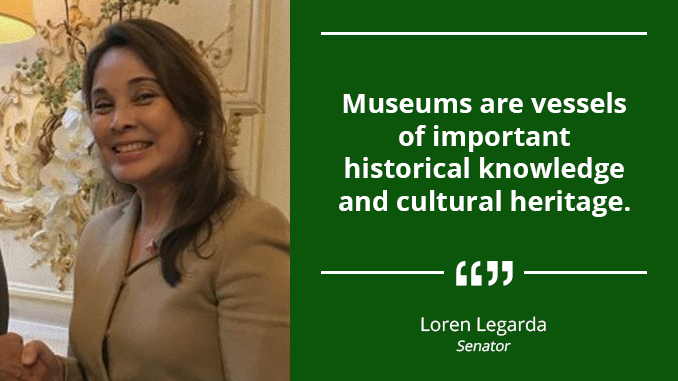In celebration of Museums and Galleries month, Senator Loren Legarda encouraged everyone to make frequent visits to museums to enrich people’s understanding of our culture and history.
Legarda, a staunch advocate of arts and culture promotion, said that museums are vessels of important historical knowledge and cultural heritage and they showcase the invaluable Filipino talent.
“I hope we can all take time to make regular visits to our museums to immerse in our history and culture. Our National Museum organizes lectures and workshops that help us better understand and appreciate our heritage. This will also help strengthen national identity and pride,” the veteran legislator said, noting that admission is now free at the National Museum.
The seasoned lawmaker has been working with the National Museum to organize lecture series and demonstrations, particularly on weaving, at the Hibla ng Lahing Filipino, the country’s first permanent textile gallery.
The lady senator is the patron of the Hibla gallery, as well as the Baybayin: Ancient and Traditional Scripts of the Philippines gallery, and the Rice, Biodiversity and Climate Change exhibit – all of which are her projects with the National Museum. She has also supported the creation of the Gawad sa Manlilikha ng Bayangallery and the exhibit on Bangsamoro heritage titled Faith, Tradition and Place.
As Chair of the Senate Committee on Finance, Legarda ensures adequate funding for the National Museum – the National Museum of Fine Arts, the National Museum of Anthropology, and the soon to open National Museum of Natural History – as well as its regional museums, which will also host Hiblagalleries featuring the various regions’ traditional textiles and weaving heritage. The National Museum in Ilocos Sur already has its Hibla Iloko gallery, which the Senator also supported.
“We have a very rich heritage, so rich that we have a lot to learn and understand about the practices, traditions, and ways of living of our ancestors; we have to embrace the culture that is unique to us, so we can have a better understanding of our roots and of who we are. Our museums will help us learn about these things,” she stressed.
Legarda also explained that the country’s participation in the Venice Biennale helps promote museums, both private and public, especially since some of the curators of the Philippine Pavilion are museum curators or directors as well, like Dr. Patrick Flores of the Vargas Museum at the University of the Philippines who was the curator of Tie A String Around The World, the Philippine Pavilion at the 2015 Venice Art Biennale; and Joselina “Yeyey” Cruz of the Museum of Contemporary Art and Design (MCAD) at the De La Salle University-College of St. Benilde who curated The Spectre of Comparison, the Philippine Pavilion at the present 2017 Venice Art Biennale.
“Our national pavilions at the Venice Biennale are also scheduled for homecoming exhibitions. In December 2016, we had the homecoming of Tie A String Around The World at the Vargas Museum. This month, we will have the homecoming ofMuhon: Traces of an Adolescent City at the Metropolitan Museum of Manila. This allows Filipinos to see what we exhibited in Venice and, at the same time, it is also a way to promote our museums,” said Legarda, the visionary and principal advocate of the Philippine participation in the Venice Biennale.
Muhon, which was curated by Leandro Y. Locsin Jr., Sudarshan Khadka Jr., and Juan Paolo dela Cruz of Leandro V. Locsin Partners (LVLP), was the Philippine Pavilion at the 2016 Venice Architecture Biennale. It will have its homecoming from October 27 to December 30, 2017 at the Metropolitan Museum of Manila (MET).
The MET also hosted last year the inaugural Curatorial Intensive in Manila by the New York-based Independent Curators International (ICI). The project, a development program for curators, was spearheaded by Senator Legarda and the National Commission for Culture and the Arts (NCCA).
Meanwhile, Legarda has also proposed the creation of folk art museums in every region in the country through Senate Bill No. 420.
These regional museums will feature traditional folk arts collection aside from the local archeological finds, objects of art, and other local cultural treasures, and will lead the conservation, preservation and promotion of the cultural heritage of the Schools of Living Traditions (SLTs) found within their localities.
“With these regional museums showcasing traditional folk arts we hope to start a cultural revolution through an immersion in the Philippine arts from the ordinary folks of old. We also hope that these museums will help develop craftsmanship and industry, national identity and pride, and will help unite Filipinos,” Legarda concluded.

